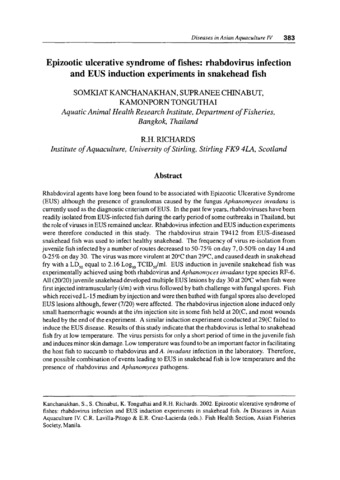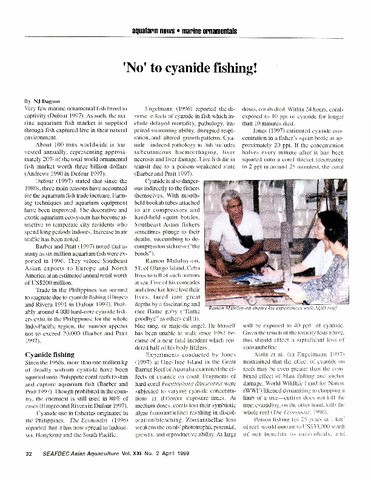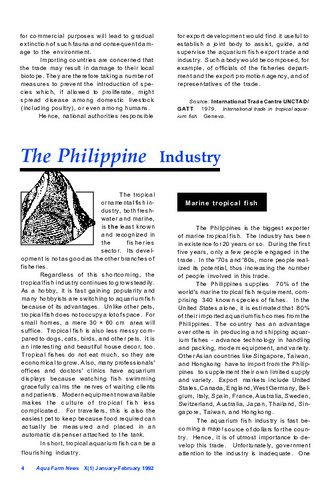Epizootic ulcerative syndrome of fishes: rhabdovirus infection and EUS induction experiments in snakehead fish
- Global styles
- MLA
- Vancouver
- Elsevier - Harvard
- APA
- Help

View/
Date
2002Page views
800ASFA keyword
AGROVOC keyword
Taxonomic term
Metadata
Show full item record
Share
Abstract
Rhabdoviral agents have long been found to be associated with Epizootic Ulcerative Syndrome (EUS) although the presence of granulomas caused by the fungus Aphanomyces invadans is currently used as the diagnostic criterium of EUS. In the past few years, rhabdoviruses have been readily isolated from EUS-infected fish during the early period of some outbreaks in Thailand, but the role of viruses in EUS remained unclear. Rhabdovirus infection and EUS induction experiments were therefore conducted in this study. The rhabdovirus strain T9412 from EUS-diseased snakehead fish was used to infect healthy snakehead. The frequency of virus re-isolation from juvenile fish infected by a number of routes decreased to 50-75% on day 7, 0-50% on day 14 and 0-25% on day 30. The virus was more virulent at 20°C than 29°C, and caused death in snakehead fry with a LD50 equal to 2.16 Log10 TCID50/ml. EUS induction in juvenile snakehead fish was experimentally achieved using both rhabdovirus and Aphanomyces invadans type species RF-6. All (20/20) juvenile snakehead developed multiple EUS lesions by day 30 at 20°C when fish were first injected intramuscularly (i/m) with virus followed by bath challenge with fungal spores. Fish which received L-15 medium by injection and were then bathed with fungal spores also developed EUS lesions although, fewer (7/20) were affected. The rhabdovirus injection alone induced only small haemorrhagic wounds at the i/m injection site in some fish held at 20(C, and most wounds healed by the end of the experiment. A similar induction experiment conducted at 29(C failed to induce the EUS disease. Results of this study indicate that the rhabdovirus is lethal to snakehead fish fry at low temperature. The virus persists for only a short period of time in the juvenile fish and induces minor skin damage. Low temperature was found to be an important factor in facilitating the host fish to succumb to rhabdovirus and A. invadans infection in the laboratory. Therefore, one possible combination of events leading to EUS in snakehead fish is low temperature and the presence of rhabdovirus and Aphanomyces pathogens.
Suggested Citation
Kanchanakhan, S., Chinabut, S., Tonguthai, K., & Richards, R. H. (2002). Epizootic ulcerative syndrome of fishes: Rhabdovirus infection and EUS induction experiments in snakehead fish. In C. R. Lavilla-Pitogo & E. R. Cruz-Lacierda (Eds.), Diseases in Asian aquaculture IV: Proceedings of the Fourth Symposium on Diseases in Asian Aquaculture, 22-26 November 1999, Cebu City, Philippines (pp. 383-394). Fish Health Section, Asian Fisheries Society.
Type
Conference paperISBN
9718020160Collections
Related items
Showing items related by title, author, creator and subject.
-
'No' to cyanide fishing!
Dagoon, N. J. (Aquaculture Department, Southeast Asian Fisheries Development Center, 1999) -
Larval and early juvenile development of silver therapon, Leiopotherapon plumbeus (Actinopterygii: Perciformes: Terapontidae), reared in mesocosms
Aya, Frolan ; Corpuz, Mark Nell C.; Laron, Manuel A.; Garcia, Luis Maria
; Corpuz, Mark Nell C.; Laron, Manuel A.; Garcia, Luis Maria  (Szczecińskie Towarzystwo Naukowe, 2017)
The silver therapon, Leiopotherapon plumbeus (Kner, 1864), is an endemic and economically important freshwater food fish in the Philippines. The natural populations of this species have been declining during the past years, ...
(Szczecińskie Towarzystwo Naukowe, 2017)
The silver therapon, Leiopotherapon plumbeus (Kner, 1864), is an endemic and economically important freshwater food fish in the Philippines. The natural populations of this species have been declining during the past years, ... -
The Philippine industry: Marine tropical fish
Castaños, Milagros T.; Southeast Asian Fisheries Development Center, Aquaculture Department (Aquaculture Department, Southeast Asian Fisheries Development Center, 1992)





